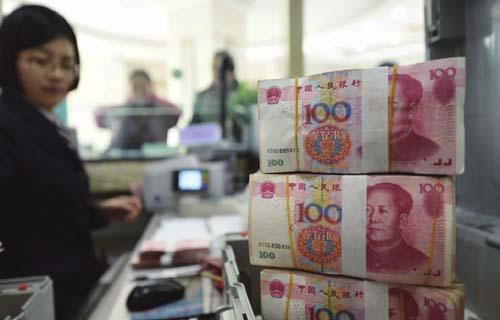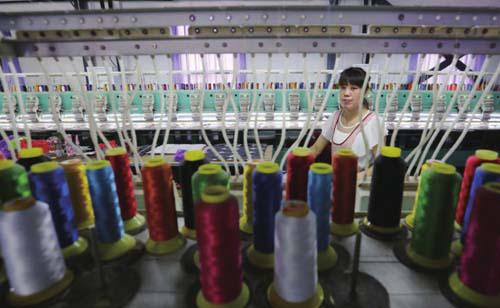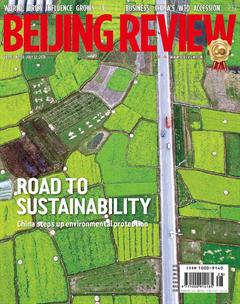Propping Up Growth
By Deng Yaqing
Chinas central bank again lowered its reserve requirement ratio (RRR) to deleverage and alleviate fi nancing diffi culties for small and micro-sized enterprises. This is the third time this year that the central bank has done so to promote inclusive fi nance and allow banks to repay medium-term lending facility.
On June 24, the Peoples Bank of China(PBC) announced a cut to the RRR of commercial banks by 0.5 percentage points, effective from July 5. More specifi cally, funds released by the five largest state-owned Chinese banks—Industrial and Commercial Bank of China, China Construction Bank, Agricultural Bank of China, Bank of China and Bank of Communications—along with 12 joint-stock commercial banks, including China CITIC Bank and China Everbright Bank, could amount to nearly 500 billion yuan($75.4 billion).
The PBC made clear in a statement that the money should be used to support debt-to-equity swap projects on a marketoriented and legal basis, and to leverage the same amount of private capital participating in the investment.
Furthermore, another 200 billion yuan($30.2 billion) will be released from postal savings banks, city and non-county rural commercial banks and foreign banks to lower fi nancing costs for small and microsized companies.
In both cases, financial institutionsactivities will be supervised by the central banks macro prudential assessment framework consisting of a host of tightened regulatory standards to prevent a systemic fi nancial crisis, according to the PBC.
Targeted Move
Since the beginning of the year, limited progress has been made in the contracting and financing of debt-to-equity swap projects. Considering that large state-owned and joint-stock commercial banks are the main force for propelling these swaps, a decision was made to release some long-term funds through targeted RRR cuts in order to improve the capacity of banks to carry out such projects, the PBC said.
Debt-to-equity swap projects, which have been promoted by the government since 2015 to reduce corporate debt ratios, should be employed to improve enterprises balance sheets, while swaps for“zombie” enterprises—poorly performing businesses—should not be approved, the PBC pointed out.
During the process of deleveraging, some companies have to go through bankruptcy and reorganization. Debt-to-equity swaps serve as a cushion to transform them from business failure to normal operations, said Fan Wei, chief analyst for fi xedincome products with Shenwan Hongyuan Securities, in an interview with National Business Daily. He added that commercial banks are allowed to hold equity swapped from debt for two years according to related laws and regulations.
Debt-to-equity swaps are an effective tool to reduce the leverage of the macro economy. However, such projects have not done well recently. Thus, the targeted RRR cut will not only free up more funds to strengthen banks capacity to implement debt-to-equity swaps, but also focus more attention and energy on the area, Zeng Gang, a research fellow with the Financial Research Institute of the Chinese Academy of Social Sciences, told Beijing Business Today. He also noted that the move has created better conditions for managing and controlling the leverage of the macro economy.
Meanwhile, fi nancing is still very expensive and diffi cult for small and micro-sized companies in China. Since postal savings banks and city and non-county rural commercial banks play an important role in this area, targeted RRR reductions for these banks will empower them to issue more loans and thus lower financing costs, according to the PBC.
“Deleveraging efforts, originally targeted at state-owned enterprises, have fallen on small and medium-sized companies, which have seen their financing channels further squeezed. Through means such as asset securitization, many state-owned enterprises have managed to move debt off of their balance sheets,” said Fan.
“In 2015 and 2016 when the financing environment was quite loose, small and micro-sized companies raised a large amount of funds to sustain their operations. Now, most of them are faced with the expiration of these bonds and loans, while their fi nancing channels are clogged by the overall deleveraging environment,”added Fan, suggesting that the RRR cut is targeted to alleviate the pressure these companies are experiencing.
In addition, there has been a severe shortage of liquidity in the market, which has exerted a negative infl uence on fi xedasset investment and consumption growth, as well as the production and operation of market players, Xu Hongcai, deputy chief economist with the China Center for International Economic Exchanges, told Beijing Review. He added that since July 2017, M2—a broad measure of money supply that covers cash both in circulation and deposits—grew slightly more than 8 percent, slower than the nominal GDP.
Future direction
The central bank made it clear that its monetary policy remains prudent and neutral, and it promised to maintain an appropriate monetary and financial environment for high-quality development and supply-side structural reform.
Taking into account the overall international picture, central banks across the world are withdrawing from quantitative easing. In such a context, China is not likely to go against the tide, Fan said.
As to the monetary policy China should adopt in the future, Fan advised that the overall trend of deleveraging should not be reversed because the current debt ratio is still relatively high; financing costs should be lowered, along with a commitment to reducing leverage; debt-to-equity swaps need to be further promoted to break up past debt chains; and creditors and debtors should share risks, with rigid payment being eliminated.
Zeng said there is room for further RRR cuts, especially targeted ones. In the days to come, structural deleverage is the key task, requiring the application of structural policies which can integrate credit control with structural adjustments.
In the future, while maintaining the stability and continuity of policies, Chinese authorities should be fl exible, targeted and far-sighted in formulating regulatory policies, Xu suggested.
He also said there is plenty of room for more targeted RRR cuts, which will make available more low-cost, long-term credit funds, help fuel the real economy and ensure stability of the money market.

